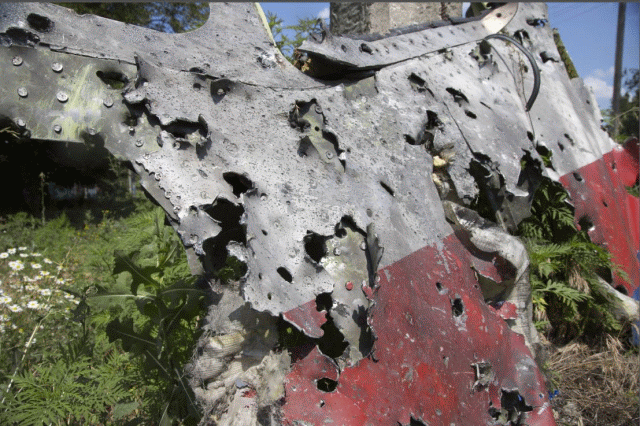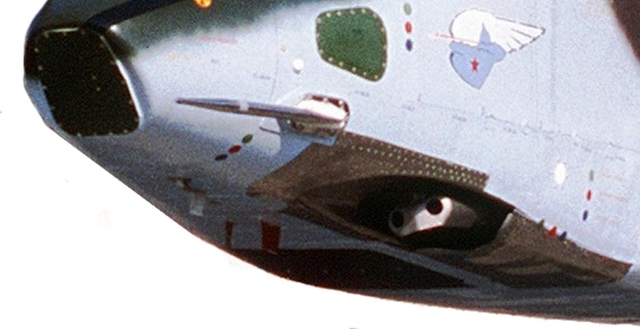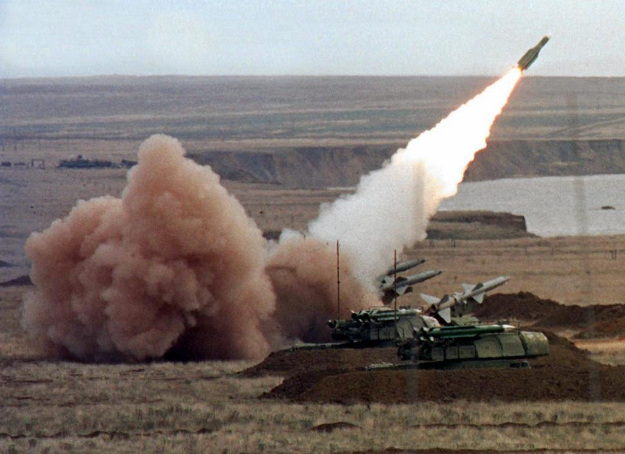It looks like you're using an Ad Blocker.
Please white-list or disable AboveTopSecret.com in your ad-blocking tool.
Thank you.
Some features of ATS will be disabled while you continue to use an ad-blocker.
4
share:
Well it seems they had the Buk missile and launcher , it is capable of reaching 50,000 feet and went into service in 1979 in the Soviet Union and
more than 500,000 have been made.
www.popsci.com...
Earlier today, Malaysia Airlines flight MH-17, flying from Amsterdam to Kuala Lumpur, was shot down over Eastern Ukraine, killing all 295 people on board. Following Ukraine's ouster of Russian-backed President Viktor Yanukovich, and the subsequent seizure of Crimea from Ukraine by Russia, a violent and armed separatist movement emerged in Eastern Ukraine, centered around the city of Donetsk. These Donetsk rebels, with help from a certain foreign backer, have successfully shot down several Ukrainian military aircraft. Now, it looks like intentionally or not, they destroyed a civilian aircraft
www.popsci.com...
From what I read the Ukrainian seperarist had acquired the missile system, then they shot down a few military aircraft, one of which had 49 people on
board, now this happened, they just brought a whole lot of trouble down there pipe hole.
Ummm.... many countries have this capability-including our own US.
Just sayin'.....
Will we ever know the truth? I don't think so. We will be given information to make us believe whatever we are supposed to believe, and more often than not, there seems to be little to no truth in the 'official' stories anymore.
Just sayin'.....
Will we ever know the truth? I don't think so. We will be given information to make us believe whatever we are supposed to believe, and more often than not, there seems to be little to no truth in the 'official' stories anymore.
BUK missile system?
I picked that up from NATO source via hashbotapp.
I picked that up from NATO source via hashbotapp.
Buk missile launcher that reportedly took out Malaysia Airlines Flight MH17 developed by Soviet Union
Can someone put up a picture of a Buk system with all of it all of its modules.
Maybe one deployed and one with the system packed up?
Maybe one deployed and one with the system packed up?
The BUK is a family of systems which are commonly known as the SA-11 (GADFLY) or the SA-17 (GRIZZLY).
a reply to: nighthawk1954
Only the butt nugget could blame this on anybody but the Russians, just sayin. The Russian separatists have done this before using Russian weapons gave to them by Putin. Where is the mystery here. I think even the Russian shills will have a hard time blaming somebody else. I do see that RT is though. but it's a state sponsored propaganda news channel so it was to be expected.
Only the butt nugget could blame this on anybody but the Russians, just sayin. The Russian separatists have done this before using Russian weapons gave to them by Putin. Where is the mystery here. I think even the Russian shills will have a hard time blaming somebody else. I do see that RT is though. but it's a state sponsored propaganda news channel so it was to be expected.
I'm sure Russian Rebels are using with Russian and Ukranian military weapons.
Maybe hard to pin point on whom.
Maybe hard to pin point on whom.
a reply to: nighthawk1954
‘You’re A Dumbass Aren’t You?’ MSNBC’s Krystal Ball Fooled By Howard Stern Fan
Read more: dailycaller.com...
Too Funny!
‘You’re A Dumbass Aren’t You?’ MSNBC’s Krystal Ball Fooled By Howard Stern Fan
Read more: dailycaller.com...
Too Funny!
Well, if the tragic loss of this airliner was the result of a missile then the BUK, or SA11, or NATO name Gadfly would seem a likely contender.
Numerously deployed within Russia and Ukraine and apparently successful in Georgia with Russian jets being shot down.
The guilty parties. Well, let's wait and see. I am sure the truth will come out. In the meantime, let's pause and consider the victims of this madness - whether it was accidental or purposeful.
Regards
The guilty parties. Well, let's wait and see. I am sure the truth will come out. In the meantime, let's pause and consider the victims of this madness - whether it was accidental or purposeful.
Regards
This post is somewhat cursory because I haven't really followed the story in depth.
Webster Tarpley mentioned in his latest broadcast at tarpley.net that a couple of references to a possible air to air shoot down of MH017 have appeared. A photo purporting to show part of this aircraft near the cockpit is alleged to feature holes alleged (by a former Luftwaffe pilot) to have come from 30 mm. cannon fire.
www.anderweltonline.com...

Two Sukhoi 25 fighter jets have been alleged to have been in the area at the time. Maybe someone in the thread can make an informed assessment of the holes shown in the photo.
Possible scenario: Two Ukrainian jets, not armed with air to air missiles, brought down the airliner with cannon fire, hoping to nail Vladimir Putin who was returning from the far east at about the same time and in the same area. It's a little far fetched, but I don't think that the idea of Ukrainian Sukhois flying armed only with cannon is far fetched or, specifically, without air to air missiles, since it is a purpose built ground attack aircraft.
Webster Tarpley mentioned in his latest broadcast at tarpley.net that a couple of references to a possible air to air shoot down of MH017 have appeared. A photo purporting to show part of this aircraft near the cockpit is alleged to feature holes alleged (by a former Luftwaffe pilot) to have come from 30 mm. cannon fire.
www.anderweltonline.com...

Two Sukhoi 25 fighter jets have been alleged to have been in the area at the time. Maybe someone in the thread can make an informed assessment of the holes shown in the photo.
Possible scenario: Two Ukrainian jets, not armed with air to air missiles, brought down the airliner with cannon fire, hoping to nail Vladimir Putin who was returning from the far east at about the same time and in the same area. It's a little far fetched, but I don't think that the idea of Ukrainian Sukhois flying armed only with cannon is far fetched or, specifically, without air to air missiles, since it is a purpose built ground attack aircraft.
edit on 4-8-2014 by ipsedixit because: (no reason given)
Looky, looky, looky.
en.wikipedia.org...-25
I wonder if the Ukrainian Su-25s were prone to problems that might have led to an accidental shoot down. Seems unlikely to me, but experts might have another opinion.
Apparently the original 6 barrel version of this weapon was very noisy and shaky, in one case shaking the pilot's instrument panel loose. Planes like the Su-25 were given the two barrel version.
en.wikipedia.org.../File:Russian_Air_Force_Su-25.jpg

Close up of the cannon:
en.wikipedia.org.../File:Gh-30-2.jpg

As an aside, this is a very cute fighter. It's the kind a cartoonist would draw, somewhat jaunty looking. It reminds me of a fighter in a cartoon I saw years ago, pictured on a small atoll in the Pacific with two spear carrying natives in grass skirts standing beside it, looking puzzled. One says to the other, "What is communism?"
en.wikipedia.org...-25
Su-25
The basic version of the aircraft was produced at Factory 31, at Tbilisi, in the Soviet Republic of Georgia. Between 1978 and 1989, 582 single-seat Su-25s were produced in Georgia, not including aircraft produced under the Su-25K export program. This variant of the aircraft represents the backbone of the Russian Air Force's Su-25 fleet, currently the largest in the world.[6] The aircraft experienced a number of accidents in operational service caused by system failures attributed to salvo firing of weapons. In the wake of these incidents, use of its main armament, the 240 mm S-24 rocket, was prohibited. In its place, the FAB-500 500 kg general-purpose high-explosive bomb became the primary armament.[6]
I wonder if the Ukrainian Su-25s were prone to problems that might have led to an accidental shoot down. Seems unlikely to me, but experts might have another opinion.
Apparently the original 6 barrel version of this weapon was very noisy and shaky, in one case shaking the pilot's instrument panel loose. Planes like the Su-25 were given the two barrel version.
en.wikipedia.org.../File:Russian_Air_Force_Su-25.jpg

Close up of the cannon:
en.wikipedia.org.../File:Gh-30-2.jpg

As an aside, this is a very cute fighter. It's the kind a cartoonist would draw, somewhat jaunty looking. It reminds me of a fighter in a cartoon I saw years ago, pictured on a small atoll in the Pacific with two spear carrying natives in grass skirts standing beside it, looking puzzled. One says to the other, "What is communism?"
edit on 4-8-2014 by ipsedixit because: (no reason given)
This is quoted from an interview with an official investigator who arrived days before the main body of investigators did. The wreckage was still
smoldering when he got there. He says some of the wreckage was pockmarked with what looked like holes made by machine guns.
www.nst.com.my...
I wonder if for some reason the pilots of the fighters that presumably brought MH017 down wanted to kill the pilots of the airliner immediately to eliminate the possibility of radio calls as the plane went down.
www.nst.com.my...
Parry also cited a July 29 Canadian Broadcasting Corporation interview with Michael Bociurkiw, one of the first Organisation for Security and Cooperation in Europe (OSCE) investigators to arrive at the scene of the disaster, near Donetsk.
Bociurkiw is a Ukrainian-Canadian monitor with OSCE who, along with another colleague, were the first international monitors to reach the wreckage after flight MH17 was brought down over eastern Ukraine.
In the CBC interview, the reporter in the video preceded it with: “The wreckage was still smouldering when a small team from the OSCE got there. No other officials arrived for days”.
“There have been two or three pieces of fuselage that have been really pockmarked with what almost looks like machinegun fire; very, very strong machinegun fire,” Bociurkiw said in the interview.
Parry had said that Bociurkiw’s testimony is “as close to virgin, untouched evidence and testimony as we’ll ever get. Unlike a black-box interpretation-analysis long afterward by the Russian, British or Ukrainian governments, each of which has a horse in this race, this testimony from Bociurkiw is raw, independent and comes from one of the two earliest witnesses to the physical evidence.
“That’s powerfully authoritative testimony. Bociurkiw arrived there fast because he negotiated with the locals for the rest of the OSCE team, who were organising to come later,” Parry had said.
I wonder if for some reason the pilots of the fighters that presumably brought MH017 down wanted to kill the pilots of the airliner immediately to eliminate the possibility of radio calls as the plane went down.
originally posted by: ipsedixit
...
Possible scenario: Two Ukrainian jets, not armed with air to air missiles, brought down the airliner with cannon fire, hoping to nail Vladimir Putin who was returning from the far east at about the same time and in the same area. It's a little far fetched, but I don't think that the idea of Ukrainian Sukhois flying armed only with cannon is far fetched or, specifically, without air to air missiles, since it is a purpose built ground attack aircraft.
The important word in your post is FAR.
Even the newest Su-25K has a service ceiling of 7000 meters, clean (i.e., without external stores) - taken from Sukhoi webpage. MH-17 was flying at 33.000ft, ~11km. Even if we allow for some higher actual ceiling by the Su-25 compared to its official figures, there is no way this ground attack aircraft could have reached out and touched the Boeing. It should also not be able to match the speed of an airliner at altitude (with engines and aerodynamics optimized for mid- and low altitude performance).
By the way, the quoted pilot was no Luftwaffe airman, "only" a commercial pilot before turning "alternative" writer.
originally posted by: ipsedixit[
This is quoted from an interview with an official investigator who arrived days before the main body of investigators did. The wreckage was still smoldering when he got there. He says some of the wreckage was pockmarked with what looked like holes made by machine guns. ...
Big correction:
The quoted person was NOT an investigator, he was an OSCE monitor - a political worker. With no apparent background in either military aviation nor aerospace investigation. "Strong mahine gun fire"? I cant even think of any modern tactical airplane armed with machine guns. Especially not Soviet/Russian models who have favoured rather large caliber cannons since WW2.
In my view, your posted photo pretty clearly shows large surface shrapnel damage. Cannon shot should show much more concentrated damage, either really round "stamped" holes from armor piercing and FAP rounds, or several much larger holes from Hi-explosive ammunition. Not this ragged, uneven surface that is dinged and dented across the whole surface. But I dont claim to be an expert either, only a somewhat informed amateur.
edit on
16/8/2014 by Lonestar24 because: (no reason given)
new topics
-
Alien warfare predicted for December 3 2024
Aliens and UFOs: 1 hours ago -
Statements of Intent from Incoming Trump Administration Members - 2025 to 2029.
2024 Elections: 10 hours ago -
Could Biden pardon every illegal alien
Social Issues and Civil Unrest: 11 hours ago -
Stop the Presses! Turkey Soup.
Food and Cooking: 11 hours ago
top topics
-
Statements of Intent from Incoming Trump Administration Members - 2025 to 2029.
2024 Elections: 10 hours ago, 8 flags -
Could Biden pardon every illegal alien
Social Issues and Civil Unrest: 11 hours ago, 7 flags -
Stop the Presses! Turkey Soup.
Food and Cooking: 11 hours ago, 5 flags -
Alien warfare predicted for December 3 2024
Aliens and UFOs: 1 hours ago, 5 flags -
'Proud Prophet' 12 Day Exercise Predicted Global Nuclear Catastrophe
World War Three: 17 hours ago, 4 flags
active topics
-
Never say Never?
Science & Technology • 35 • : andy06shake -
Alien warfare predicted for December 3 2024
Aliens and UFOs • 5 • : DAVID64 -
Lies lies lies, green energy is black.
The Gray Area • 31 • : KrustyKrab -
Unidentified Flying Objects Over U.S. Military Bases in Northeast UK, as of roughly 11 a.m. CST.
Aliens and UFOs • 41 • : Skinnerbot -
Statements of Intent from Incoming Trump Administration Members - 2025 to 2029.
2024 Elections • 13 • : nugget1 -
Assad flees to moscow
World War Three • 47 • : ufoorbhunter -
Australia passes social media ban for children under 16
Social Issues and Civil Unrest • 24 • : PorkChop96 -
The Reactionary Conspiracy 13. The plot’s theology.
General Conspiracies • 321 • : andy06shake -
Jaguar Rebrand Video Causes "WTF?" Moment - Seriously Weird
Automotive Discussion • 41 • : Encia22 -
Biden pardons his son Hunter despite previous pledges not to
Mainstream News • 113 • : Freeborn
4

